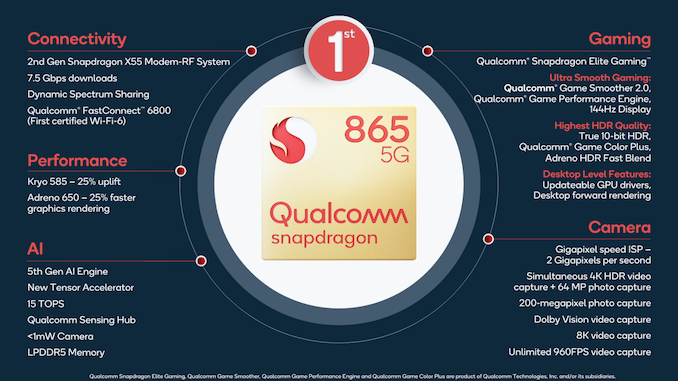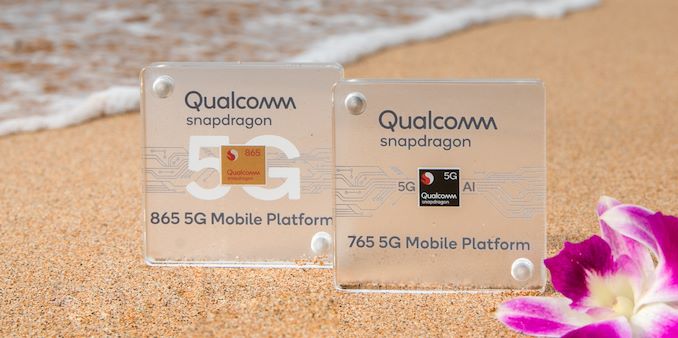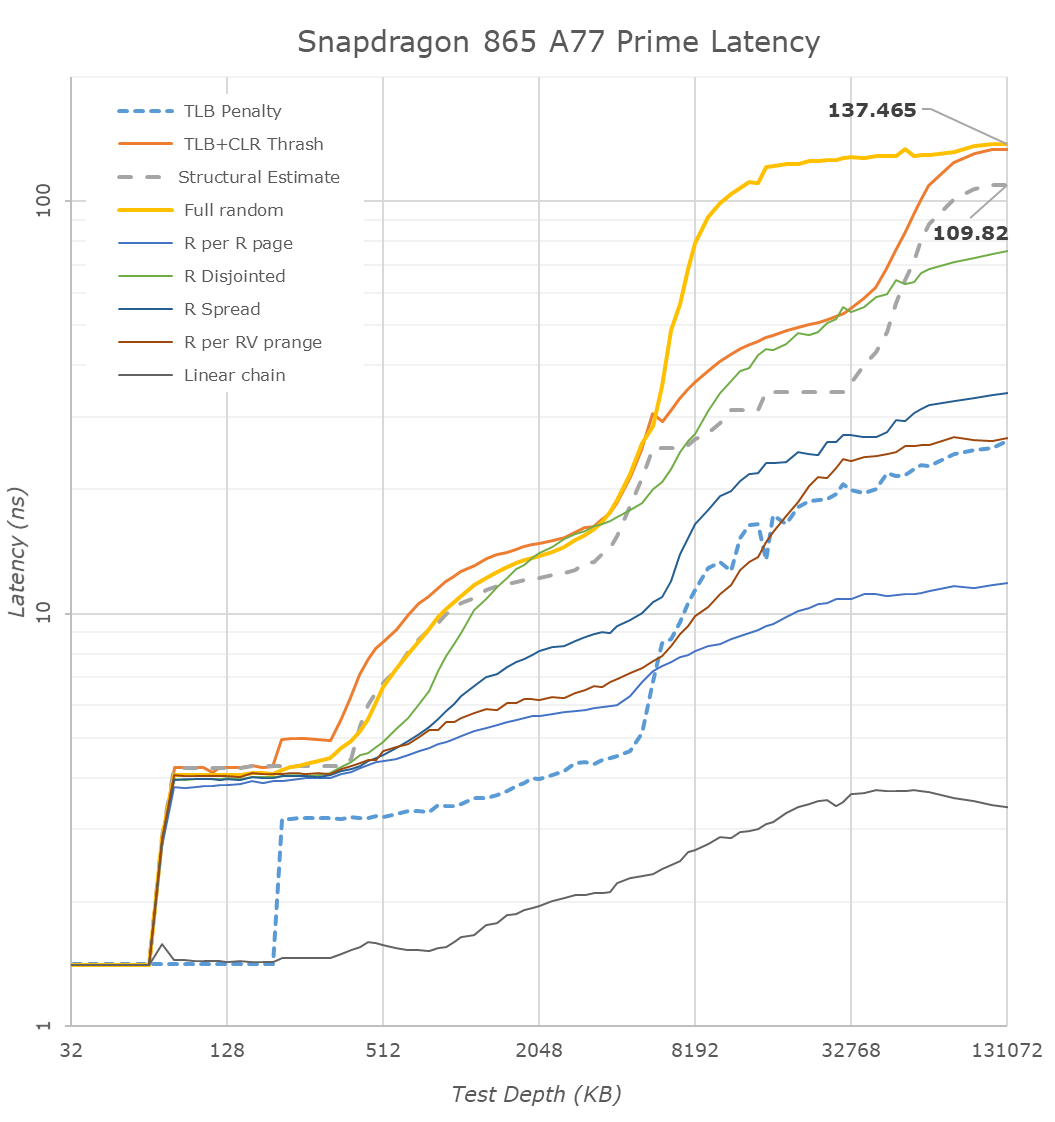The Snapdragon 865 Performance Preview: Setting the Stage for Flagship Android 2020
by Andrei Frumusanu on December 16, 2019 7:30 AM EST- Posted in
- Mobile
- Qualcomm
- Smartphones
- 5G
- Cortex A77
- Snapdragon 865

Earlier this month we had the pleasure to attend Qualcomm’s Maui launch event of the new Snapdragon 865 and 765 mobile platforms. The new chipsets promise to bring a lot of new upgrades in terms of performance and features, and undoubtedly will be the silicon upon which the vast majority of 2020 flagship devices will base their designs on. We’ve covered the new improvements and changes of the new chipset in our dedicated launch article, so be sure to read that piece if you’re not yet familiar with the Snapdragon 865.
As has seemingly become a tradition with Qualcomm, following the launch event we’ve been given the opportunity to have some hands-on time with the company’s reference devices, and had the chance to run the phones through our benchmark suite. The QRD865 is a reference phone made by Qualcomm and integrates the new flagship chip. The device offers insight into what we should be expecting from commercial devices in 2020, and today’s piece particularly focuses on the performance improvements of the new generation.
- Qualcomm Announces Snapdragon 865 and 765(G): 5G For All in 2020, All The Details
- Qualcomm Windows on Snapdragon: New 7c & 8c SoCs for sub-$800 Laptops
- Quick Bytes: Qualcomm’s Dynamic Spectrum Sharing Demo with 5G and 4G
- Quick Bytes: Qualcomm’s Prediction of 1.4 Billion 5G Smartphones by 2022
- Qualcomm Snapdragon Tech Summit Live Blog: Day One
- Qualcomm Snapdragon Tech Summit Live Blog Day Two: All About Mobile
- Qualcomm Snapdragon Tech Summit Day 3 Live Blog: ACPC and XR
A quick recap of the Snapdragon 865 if you haven’t read the more thorough examination of the changes:
| Qualcomm Snapdragon Flagship SoCs 2019-2020 | |||
| SoC |
Snapdragon 865 |
Snapdragon 855 | |
| CPU | 1x Cortex A77 @ 2.84GHz 1x512KB pL2 3x Cortex A77 @ 2.42GHz 3x256KB pL2 4x Cortex A55 @ 1.80GHz 4x128KB pL2 4MB sL3 @ ?MHz |
1x Kryo 485 Gold (A76 derivative) @ 2.84GHz 1x512KB pL2 3x Kryo 485 Gold (A76 derivative) @ 2.42GHz 3x256KB pL2 4x Kryo 485 Silver (A55 derivative) @ 1.80GHz 4x128KB pL2 2MB sL3 @ 1612MHz |
|
| GPU | Adreno 650 @ 587 MHz +25% perf +50% ALUs +50% pixel/clock +0% texels/clock |
Adreno 640 @ 585 MHz |
|
| DSP / NPU | Hexagon 698 15 TOPS AI (Total CPU+GPU+HVX+Tensor) |
Hexagon 690 7 TOPS AI (Total CPU+GPU+HVX+Tensor) |
|
| Memory Controller |
4x 16-bit CH @ 2133MHz LPDDR4X / 33.4GB/s or @ 2750MHz LPDDR5 / 44.0GB/s 3MB system level cache |
4x 16-bit CH @ 1866MHz LPDDR4X 29.9GB/s 3MB system level cache |
|
| ISP/Camera | Dual 14-bit Spectra 480 ISP 1x 200MP 64MP ZSL or 2x 25MP ZSL 4K video & 64MP burst capture |
Dual 14-bit Spectra 380 ISP 1x 192MP 1x 48MP ZSL or 2x 22MP ZSL |
|
| Encode/ Decode |
8K30 / 4K120 10-bit H.265 Dolby Vision, HDR10+, HDR10, HLG 720p960 infinite recording |
4K60 10-bit H.265 HDR10, HDR10+, HLG 720p480 |
|
| Integrated Modem | none (Paired with external X55 only) (LTE Category 24/22) DL = 2500 Mbps 7x20MHz CA, 1024-QAM UL = 316 Mbps 3x20MHz CA, 256-QAM (5G NR Sub-6 + mmWave) DL = 7000 Mbps UL = 3000 Mbps |
Snapdragon X24 LTE (Category 20) DL = 2000Mbps 7x20MHz CA, 256-QAM, 4x4 UL = 316Mbps 3x20MHz CA, 256-QAM |
|
| Mfc. Process | TSMC 7nm (N7P) |
TSMC 7nm (N7) |
|
The Snapdragon 865 is a successor to the Snapdragon 855 last year, and thus represents Qualcomm’s latest flagship chipset offering the newest IP and technologies. On the CPU side, Qualcomm has integrated Arm’s newest Cortex-A77 CPU cores, replacing the A76-based IP from last year. This year Qualcomm has decided against requesting any microarchitectural changes to the IP, so unlike the semi-custom Kryo 485 / A76-based CPUs which had some differing aspects to the design, the new A77 in the Snapdragon 865 represents the default IP configuration that Arm offers.
Clock frequencies and core cache configurations haven’t changed this year – there’s still a single “Prime” A77 CPU core with 512KB cache running at a higher 2.84GHz and three “Performance” or “Gold” cores with reduced 256KB caches at a lower 2.42GHz. The four little cores remain A55s, and also the same cache configuration as well as the 1.8GHz clock. The L3 cache of the CPU cluster has been doubled from 2 to 4MB. In general, Qualcomm’s advertised 25% performance uplift on the CPU side solely comes from the IPC increases of the new A77 cores.
The GPU this year features an updates Adreno 650 design which increases ALU and pixel rendering units by 50%. The end-result in terms of performance is a promised 25% upgrade – it’s likely that the company is running the new block at a lower frequency than what we’ve seen on the Snapdragon 855, although we won’t be able to confirm this until we have access to commercial devices early next year.
A big performance upgrade on the new chip is the quadrupling of the processing power of the new Tensor cores in the Hexagon 698. Qualcomm advertises 15 TOPS throughput for all computing blocks on the SoC and we estimate that the new Tensor cores roughly represent 10 TOPS out of that figure.
In general, the Snapdragon 865 promises to be a very versatile chip and comes with a lot of new improvements – particularly 5G connectivity and new camera capabilities are promised to be the key features of the new SoC. Today’s focus lies solely on the performance of the chip, so let’s move on to our first test results and analysis.
New Memory Controllers & LPDDR5: A Big Improvement
One of the larger changes in the SoC this generation was the integration of a new hybrid LPDDR5 and LPDDR4X memory controller. On the QRD865 device we’ve tested the chip was naturally equipped with the new LP5 standard. Qualcomm was actually downplaying the importance of LP5 itself: the new standard does bring higher memory speeds providing better bandwidth, however latency should be the same, and power efficiency benefits, while there, shouldn’t be overplayed. Nevertheless, Qualcomm did claim they focused more on improving their memory controllers, and this year we’re finally seeing the new chip address some of the weaknesses exhibited by the past two generations; memory latency.
We had criticised Qualcomm’s Snapdragon 845 and 855 for having quite bad memory latency – ever since the company had introduced their system level cache architecture to the designs, this aspect of the memory subsystem had seen some rather mediocre characteristics. There’s been a lot of arguments in regards to how much this actually affected performance, with Qualcomm themselves naturally downplaying the differences. Arm generally notes a 1% performance difference for each 5ns of latency to DRAM, if the differences are big, it can sum up to a noticeable difference.
Looking at the new Snapdragon 865, the first thing that pops up when comparing the two latency charts is the doubled L3 cache of the new chip. It’s to be noted that it does look that there’s still some sort of logical partitioning going on and 512KB of the cache may be dedicated to the little cores, as random-access latencies start going up at 1.5MB for the S855 and 3.5MB for the S865.
Further down in the deeper memory regions, we’re seeing some very big changes in latency. Qualcomm has been able to shave off around 35ns in the full random-access test, and we’re estimating that the structural latency of the chip now falls in at ~109ns – a 20ns improvements over its predecessor. While it’s a very good improvements in itself, it’s still a slightly behind the designs of HiSilicon, Apple and Samsung. So, while Qualcomm still is the last of the bunch in regards to its memory subsystem, it’s no longer trailing behind by such a large margin. Keep in mind the results of the Kirin 990 here as we go into more detailed analysis of memory-intensive workloads in SPEC on the next page.
Furthermore, what’s very interesting about Qualcomm’s results in the DRAM region is the behaviour of the TLB+CLR Trash test. This test is always hitting the same cache-line within a page across different, forcing a cache line replacement. The oddity here is that the Snapdragon 865 here behaves very differently to the 855, with the results showcasing a separate “step” in the results between 4MB and ~32MB. This result is more of an artefact of the test only hitting a single cache line per page rather than the chip actually having some sort of 32MB hidden cache. My theory is that Qualcomm has done some sort of optimisation to the cache-line replacement policy at the memory controller level, and instead the test hitting DRAM, it’s actually residing at on the SLC cache. It’s a very interesting result and so far, it’s the first and only chipset to exhibit such behaviour. If it’s indeed the SLC, the latency would fall in at around 25-35ns, with the non-uniform latency likely being a result of the four cache slices dedicated to the four memory controllers.
Overall, it looks like Qualcomm has made rather big changes to the memory subsystem this year, and we’re looking forward to see the impact on performance.













178 Comments
View All Comments
Bulat Ziganshin - Monday, December 16, 2019 - link
Unfortunately the first page lack latency picture for Core i9Ryan Smith - Monday, December 16, 2019 - link
Whoops! Reload and try it now.shabby - Monday, December 16, 2019 - link
Performance looks good but I'm really wary of the external 4g/5g chip and its additional antennas and how they'll affect battery life. Not going to buy any new sd865 phone until reviews pop up.eastcoast_pete - Monday, December 16, 2019 - link
That's the elephant in the room! Haven't seen any good real-world data on just how much power 5G use will actually add. Faster data are nice (in principle), but if 5G cuts battery life by 30-40% vs. current 4G LTE , pretty much useless. If anyone here has any links to such tests, please post - Thanks!Kangal - Friday, December 20, 2019 - link
Well, I think generally they're going to stick the 5G SoC next to the QSD 865 SoC.That means heat from one will affect the other, and so OEMs will potentially require a larger phone (and larger screen = more drain), but with a smaller area for the battery.
Not to mention, there is going to be significant battery life hit when using an external radio chipset instead of an integrated one. Remember the huge power savings we saw going from the QSD 600 to the QSD 800 back in 2013. So it will be kind of reversed.
I think overall, what will happen is that all the improvements in the battery technology and the Cortex A77 are going to be nullified. So phones from 2019 which had the best battery life and performance, are going to see a "side-grade" compared to 2020 flagships. So I believe in essence, the QSD 865 will be much less competitive against the Apple A13 and Exynos 990... compared to the QSD 855 against the Apple A12 and Kirin 980.
...I do believe more in-depth benchmarks and reviews will come within 3 months (and validate my hypothesis).
MrCommunistGen - Monday, December 16, 2019 - link
Based on the initial performance estimates from the Cortex A77 announcement article Andrei published back in May, I was actually really excited to see the next generation Snapdragon 865. The lack of performance uplift in the real-world web metrics with the QRD865 is a bit underwhelming, but my main concern is the requirement of an external modem.I don't have any experience with the current crop of 5G external-modem devices, but back in the day I used several Qualcomm APQ external-modem devices. Back then battery life being terrible was basically a given since batteries were small and Android was pretty bad at power management, but in hindsight I'm sure at least some of it was due to the external modems...
tuxRoller - Wednesday, December 18, 2019 - link
The disappointing web improvements were also seen last year (https://www.anandtech.com/show/13786/snapdragon-85..."The web-based benchmarks such as Speedometer 2.0 and WebXPRT 3 showcase similar relatively muted results. Here I had expected Qualcomm to perform really well given the scheduler performance showcase of the Snapdragon 845. The results of the Snapdragon 855 are quite meagre, especially in a steady-state throughput workload such as Speedometer 2.0. Here the Snapdragon 855 only manages to showcase a ~17% improvement over the last generation, and also lags behind the Kirin 980 by some notable amount."
However, compare those 855qrd to the numbers seen in this article with actual shipping devices. Pretty big difference.
generalako - Monday, December 16, 2019 - link
>Not going to buy any new sd865 phone until reviews pop up.Shouldn't really ever do that anyhow...
Kishoreshack - Monday, December 16, 2019 - link
Don't know why the Performance looks disappointing in web browsing testKishoreshack - Monday, December 16, 2019 - link
What is the reason is it performs worse than last years 855 chipare we gonna see same kind of implementation in real world devices?